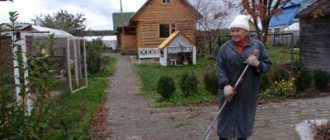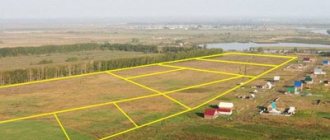Free legal consultation!
In judicial practice, cases are often considered where the plaintiff and defendant are the owners of two adjacent plots. Contiguous land plots are a part of the earth's surface, defined by federal laws, bordering another territory. The reasons for filing an application against one another can be completely different, but, studying the chronicles of the courts, one cannot help but notice: such proceedings take place over a long period of time (sometimes people can even sue for several years) and require considerable expenditure of money. Therefore, it is necessary to consider the causes of problems and other nuances of the Land Code of the Russian Federation.
What is an adjacent plot
Despite the prevalence of problems relating to land plots, Russian legislation does not have a clear definition of the concept of “adjacent land plot”. But there is an eleventh article of the Land Code on the concept as such. According to it, a land plot is a certain part of the earth's surface assigned to any owner in accordance with the legislative acts regulating this area. Further, the word “adjacent” indicates the presence of a common border.
The commentary to the eleventh article of the Land Code of the Russian Federation states: what exactly ownership is is determined by the legislator in each individual case. The wording is very vague, which makes it difficult to consider cases involving two adjacent areas. It is fair to note that in 221 federal laws this term is mentioned, but only in terms of establishing the boundaries of an adjacent plot. In paragraph 3.1, if the property has a common border, it is necessary to make changes to the cadastral documents with confirmation from the cadastral registration authorities.
The concept of a land plot as explained by the Supreme Court
On July 2, 2014, the Presidium of the Supreme Court approved a review of judicial practice on issues arising during the consideration of cases related to horticultural, gardening and dacha non-profit associations for 2010-2013:
https://www.vsrf.ru/Show_pdf.php?Id=9341
There are a couple of interesting passages regarding the land plot as an object of law. In the review about.
Thus, a land plot as an object of law (and, accordingly, an object of privatization) arises even without a description (!) of boundaries. Apparently, the authors of the text got carried away here - they probably only had in mind the “official” description of the boundaries, since without such a description the existence of the site is impossible (as they used to say, “without a boundary, it’s not a patrimony”).
In the practice of the Supreme Arbitration Court, this approach has already been sounded: see Resolution of the Presidium of the Supreme Arbitration Court dated April 22, 2008 No. 16975/07.
In principle, this echoes Part 9 of Art. 37 Federal Law on the State Property Committee: when clarifying the boundaries of a land plot, their location is determined based on the information contained in the document confirming the right to the land plot, or in the absence of such a document, from the information contained in the documents that determined the location of the boundaries of the land plot when it was formed. If the documents specified in this part are missing, the boundaries of the land plot are the boundaries that have existed on the ground for fifteen years or more and are fixed using natural objects or objects of artificial origin that make it possible to determine the location of the boundaries of the land plot.
One can also recall the example of Dutch law: A transfer of part of a parcel is possible and this part forms a separate thing even though it has not yet received its own parcel number and registration in the cadastre. The splitting of the parcel and allocation of new parcel number to the newly formed parcels is a mere administrative measure — The Boundaries of Property Rights: Netherlands National Report 2006 (LPW van Vliet).
I would agree with this “natural” approach.
Further explanations follow the same line: “Many land plots are not registered in the cadastral register or are registered in the cadastral register declaratively , when their boundaries are not defined in accordance with the requirements of land legislation. ... In the event that the exact boundaries of the land plot are not established based on the results of cadastral work..., and therefore it is not possible to establish their location on the ground, ... the location of the disputed boundary of the plot is determined by the court by comparing the actual area with that indicated in the title documents (primary land allotment documents) with the help of natural or artificial landmarks existing on the ground (perennial plantings, residential buildings, economic and domestic buildings, pipelines, etc.), provided that they are recorded in the measurement plans of technical inventory bodies, topographic surveys or other documents reflecting previously existing actual boundaries."
When the boundaries are defined in the State Property Committee, a different approach is recommended: “In such cases, the courts, regardless of the duration of existence of the actual boundaries, make decisions to bring them into line with the results of cadastral work.”
If we remember that from March 1, 2015, Art. 11.1 of the Land Code, which defines a land plot as a part of the earth’s surface, the boundaries of which are determined in accordance with federal laws , we can assume that a lot of interesting things await us regarding the concept of a land plot.
The concept of brokenness
The concept of brokenness is similarly not enshrined in any legal acts. But this phenomenon can also be given a definition according to which the border is considered broken if the turning points of the land ownership boundary have some special location due to natural reasons (uneven landscape, unsuitable soil for construction or other conditions). According to the law, boundaries are determined by demarcation, which gives rise to the concept of accessibility of installation of boundary signs. That is, if for physical reasons it cannot be established, then the border will not be drawn. As a result of this, fracture occurs.
The result of broken boundaries of a land plot can be:
- problems with neighboring areas, namely the definition and coordination of property boundaries;
- difficult conditions for cultivation and other land cultivation, as well as construction and installation work;
- deterioration of the position of this site on the real estate market (in case of sale) due to low architectural attractiveness;
- problems when dividing the site and clarifying the boundaries with the neighboring one.
The owner's decision to combine land plots into one
If the owner wants to combine the land plots belonging to him into one territory, then he cannot do without the help of specialists in order to comply with all the rules specified in the regulations, but also to embody all his own ideas. Indeed, in each case, legislative nuances of such a procedure may appear.
To carry out the consolidation of land plots in any option, it will be necessary to carry out preliminary surveying, which is, in fact, a set of works, which, among other things, includes calling cadastral service workers to the site to carry out geodetic measurements using equipment using satellites and fixing the boundaries of the new plot with conventional boundary lines signs.
Based on the results of the procedure, a boundary document (plan) is drawn up that complies with the standards prescribed by law.
Boundaries of the land plot, minimum setbacks from buildings
The boundaries of ownership are established and regulated by Article 39 of the Federal Law of the Russian Federation “On Cadastral Activities”. There are several important points to highlight:
- Boundaries are determined with the participation of the owners of adjacent plots in the event that the owners own the land on the basis of one of the four basic rights (inheritance, lease, ownership and perpetual use).
- Boundaries cannot be established by the owner if the site is part of a natural object or reserve or is included in the Russian Unified Register.
- Coordination of the boundaries of a plot is permitted only with the participation of interested parties (owners of neighboring plots, heads of settlements, etc.) or in some cases of one interested party (an example is the owner of an adjacent plot). The cadastral engineer is obliged to send out notices to interested parties with the necessary information about future boundaries (no later than a month before the meeting).
- In turn, when holding a meeting, interested parties must present the necessary documents indicating their actual ownership of certain property.
Fire safety and sanitary standards oblige the establishment of a distance (setbacks) at which the boundaries from buildings should be located. The distance is selected depending on the location:
- fences and other barrier structures;
- trees growing nearby or on the site (their height and area);
- power lines, pipelines (usually gas) and other communications;
- residential buildings and non-residential buildings.
So, specifically by the numbers. Based on the “building codes and regulations”:
| Type of gap | Distance |
| From a residential building to a neighboring plot | Three meters (subject to the passage of special fire equipment) |
| Two residential buildings belonging to different properties | six meters |
| Non-residential buildings (bathhouse, greenhouse, barn) | One meter |
| Tall trees | Four meters |
| low trees | Two meters |
What are the boundaries of a land plot and what are they like?
In the process of forming a land plot as an independent unit for which ownership is available or allocated, one of the main definitions used to distinguish an object from the mass of land is the border of the land plot.
It is understood as a contour line that defines by its outline the ownership of one person or group of persons.
Initially, such a line is located exclusively on paper or electronic media, but subsequently a procedure for allocating a plot is carried out, during which boundaries are established in kind, that is, they are delineated on the ground by a closed line, within which the plot will be contained that belongs to the person under the rights of ownership or use.
What it is?
In accordance with the articles of the Land Code of the Russian Federation, the boundary of a site is understood as a line defining the location of a specific area (unit), which includes all existing subsoil, as well as the soil layer itself.
Thus, this line limits the property rights of a certain individual. or legal persons, simultaneously installing it on all buildings of the territory, as well as natural objects.
The establishment of boundaries is carried out in accordance with the coordinates of the terrain, as well as characteristic points, which are also called turning points.
When determining the boundaries of land plots, a concept such as multi-contour , that is, a single ownership consists of several selected parts that may not even intersect.
At the same time, they represent a single whole, having a gap between themselves, provoked by the passage of other land plots located by natural objects.
Kinds
When considering the concept of cadastral boundaries, in this case, two concepts are actually used that are somewhat different from each other - the cadastral boundary and the actual one.
Cadastral
The concept of a cadastral boundary can be called an official or documentary definition.
That is, this is the line that runs between the coordinates of the points determined by the cadastral engineer when drawing up the boundary plan.
In turn, the cadastral boundary is divided into two separate definitions - declared and geodetic .
At the same time, those declared can only be of an approximate nature and are practically not taken as a basis for establishing boundaries.
Geodesics contain exact coordinates and geodetic points.
Actual boundaries mean those lines that are drawn directly at the location of the plots.
Boundaries are drawn onto the area during the process of drawing up a boundary plan, when a cadastral engineer goes to the area and, after carrying out the approval procedure, establishes the turning points of the plot.
Subsequently, a line drawn between them forms a closed-type contour , which will act as the actual border.
Requirements for boundaries
In the process of forming a boundary and establishing turning or characteristic points, the cadastral engineer must take into account the requirements that it must meet.
So, you will need to follow the following rules :
- The boundaries of the allotment should not intersect with any territorial boundaries of municipal settlements or settlements;
- The contour of the plot (border of the allotment) should be as simple . That is, the ideal shape is a quadrilateral. Of course, due to natural characteristics, configurations of neighboring areas and other factors, it is not always possible to achieve minimal fracture;
- The contour of the site should not intersect adjacent plots . In such a situation, one section will overlap another (partially or even completely);
- The boundaries must be determined in such a way that the site has access to the roadway and all communications passing in the area are accessible to it.
What to do if boundaries are not set?
The absence of established boundaries for a land plot imposes a lot of restrictions on actions with it . If it is necessary to determine it, the owner or other interested party must perform a number of actions in accordance with the established procedure of the Land Code of the Russian Federation and the Federal Law regulating cadastral activities.
Engineer invitation
In fact, inviting an engineer becomes the initial stage of the land surveying process, when the owner of the plot enters into an agreement to determine the boundaries of the plot.
When choosing a geodetic organization, you must pay special attention to ensuring that the engineer performing the work has permission (license) for this type of activity , otherwise the drawn up plan will not have legal force.
Coordination with neighbors
An obligatory stage in the formation of boundaries is the moment of agreement on the passing boundary with interested parties - the neighbors of the plot, whose plots are directly in contact with the one of interest along the dividing line.
All owners of adjacent plots are notified in advance by personally delivering a notice, sending a document by email or Russian post, or publishing an advertisement in a local newspaper.
Everyone appears at the appointed time at the location of the land plot and gets acquainted with information regarding the passage of the boundary. If there are no objections, the neighbors sign as a sign of consent and the boundary is considered possible for display and display on the site.
Measurement and determination of coordinates
When determining the boundaries of an allotment, an equally important procedure is the engineer’s visit to the area to determine the establishment of turning points and the passage of boundaries. This procedure is necessary in order to take into account all the features of the terrain , as well as the actual location of neighboring areas.
Appeal to the territorial chamber
After the boundaries are established and the boundary plan is officially drawn up, the owner of the plot has the opportunity to contact the cadastral chamber. Such an appeal is carried out for the purpose of entering data on the allotment into a unified state register .
In parallel with this action, the owner has the opportunity to obtain a cadastral passport, on the basis of which it is possible to obtain ownership rights.
With what accuracy are they determined?
In the process of defining boundaries and placing them on the ground, turning points are established, between which contour lines are drawn.
Due to various factors such as engineer errors, weather conditions, erroneous information, outdated or uncorrected equipment, the accuracy of the boundaries may not be complete.
In such a situation, the law establishes certain standards that contain data on permissible errors in establishing site boundaries.
the following indicators should be established :
- For those areas that are located in the zone of a populated area - 10 cm;
- For plots intended for a summer house, home, garden, vegetable garden, etc. – 20 cm;
- For agricultural plots, this error can be greater and amount to up to 2.5 meters.
Where can I find out the boundaries of the allotment?
Many plot owners often wonder how they can obtain information regarding the boundaries of a land plot.
This information may become available after you complete the following steps :
- Obtain information on the Rosreestr website. To do this, you need to go to the portal and enter the cadastral number of the plot. The window that opens will contain all the necessary information on it, as well as data on the boundaries of the site;
- Contact the Rosreestr branch . To do this, you will need to send an official request and wait for the result. Due to the fact that this method takes quite a long time to provide information, it is no longer used so often;
- Obtaining information from cadastral documentation for the site. If you have such papers in your hands, it is enough to open the boundary plan or cadastral passport and get all the data regarding the boundaries.
An adjacent property line is a line that is superimposed over the actual property line where lot lines follow the boundary of an adjacent property. Unlike the main boundary of the site, which is built along characteristic points, such lines are determined by the interval of overlap with the adjacent land plot .
The border of the adjacent plot on the plan is displayed outside (behind the main line) and before being displayed also requires prior approval with the direct owner of the adjacent plot .
What to do in case of intersection?
The intersection of plot boundaries means their displacement in any direction, while the boundaries of the plot directly intersect .
Such cases may occur when errors occur in drawing up a boundary plan for one of the neighboring areas, or both at the same time.
In addition, such cases arise when the territory is squatted, unauthorized movement and displacement of the boundaries of the site under the influence of third-party factors.
If such errors are detected, the site owner must perform the following actions :
- Contact Rosreestr with an application to clarify the boundaries (if such a situation occurs after entering information on both sections into Rosreestr);
- Agree on the location of the boundaries of the site, if such a situation arose during the formation of the boundary plan. In this case, a similar action can be performed by a cadastral engineer;
- If it is impossible to solve the problem of crossing boundaries peacefully, file a claim in court to establish the actual boundaries and eliminate all inaccuracies or consequences of illegal actions of land owners.
The concept of brokenness
Fracture is understood as the specific placement of turning points of an allotment, which is formed by the existing adjacent allotments, the specifics of the existing soils, as well as the conditions of the relief and landscape of the area.
Ideally, the site should have only 4 characteristic points and, as a consequence, 4 boundaries. In practice, land plots are not always presented in this form, and the more such turning points there are, the more irregular the plot boundary becomes.
High irregularity significantly complicates geodetic, cartographic and topographical work.
In this regard, engineers, when determining the boundaries of the site, try to achieve minimal fracture (as far as possible in a particular situation).
Conclusion
So, when determining the boundaries of a site, an extensive list of work is carried out, during which errors may be made.
To prevent any factors - a large degree of brokenness of the site, intersection of boundaries of neighboring sites, incorrect calculation of turning points, you should contact only qualified specialists with experience in such work to draw up boundary plans.
Intersection of adjacent land plots
According to the law, the intersection of plots, that is, the displacement of one towards the other, is a cadastral error. Most often, properties intersect due to the fault of surveyors who, for some reason, did not go to the area to, for example, clarify the features of the landscape. But, besides this, intersection can occur due to:
- illegal expansion of living space by the owner (such a violation may even result in criminal liability);
- sale of land without the consent of the cadastral registration authorities (for such an act the violator is subject to administrative liability);
- technological error, failure of electronic geodetic data.
In any case, this problem requires serious analysis, often even in court. It happens that the expansion of borders occurs towards uninhabited territories, which can in some situations benefit local government or the economy (care of the land, restoration of fertile qualities, etc.). In this case, if the benefit is proven, the complaint received against the owner is canceled and not considered by the court.
Consolidation of adjacent land plots
The association is regulated by the same eleventh article of the land code, according to which:
- By uniting, two sections become one, and two cease to exist.
- If the merged properties had one owner, then he remains the owner, and if there are two, then they have the right to dispose of the new property on the basis of common use (regulated by the civil code of the Russian Federation).
- It is prohibited to combine plots that were provided on the basis of indefinite land use to several persons at once.
- If one property was encumbered with a lien and the other was not, then their merger is still permitted (the lien applies to the entire merged new plot).
Returning to the previous section, unification should not lead to broken boundaries and wedging. The process must take place exclusively in accordance with the norms of the Land Code and the federal law “On Cadastral Activities” with the consultation of a cadastral engineer. In addition to the fact that united properties can only have adjacent ones, their boundaries must not be violated.
Clarification of complex issues
- In this topic, the role of state and municipal authorities is unclear, what do their powers extend to, and do they have the right to intervene in the owner’s territory? It is important to write that the displacement of any site can generally be done at the request of government authorities and cadastral engineers. Such actions will be legal if there are stripes or gaps between the possessions. If the land belongs to a state or municipal fund, the authorized bodies may require the property to be moved in order to build utilities.
- Are properties that have only one common point contiguous? Despite the fact that the concept of a border includes a certain distance (from point to point), one point is still a full-fledged border, and before constructing such a section, agreement with the other party is necessary.
- Under what conditions is it impossible to purchase an adjacent plot? Land is not subject to redemption if it is encumbered with a mortgage or belongs to the owner in accordance with the right of perpetual use (this area has other owners).






